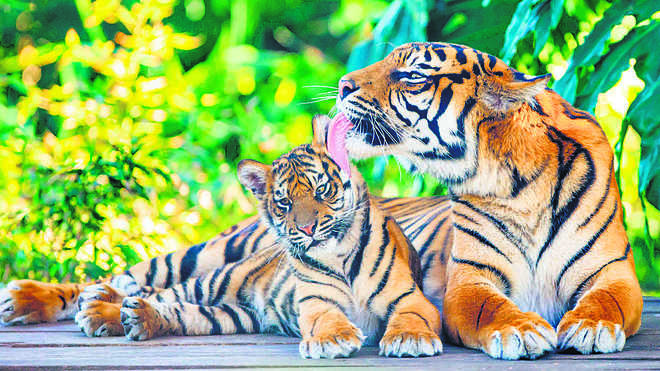At 2,967, tiger count double since 2006
Tribune News Service
New Delhi, July 29
From an abysmal low of 1,411 in 2006 to 2,226 in 2014 to 2,967 in 2018, India’s tiger population has bounced back.
Releasing the All India Tiger Estimation Report-2018, Prime Minister Narendra Modi called it a “historic achievement”, a “reaffirmation of India’s commitment” towards protecting its big cats, the “finest example of its sankalp se siddhi (attainment through resolve)” and “a moment of pride for the country for achieving its commitment to the St Petersburg Declaration of doubling Tiger population much in advance to the 2022 deadline”.
“We reaffirm our commitment towards protecting the tiger,” he today said releasing the report. “Some 15 years ago, there was serious concern about the decline in the population of tigers. It was a big challenge for us but with determination, we have achieved our goals,” he said.
“With around 3,000 tigers, India has emerged as one of the biggest and safest habitats for them in world,” Modi said, lauding the stakeholders involved in the mammoth exercise of carrying out the scientific exercise.
“Nine years ago, it was decided in St Petersburg (Russia) that the target of doubling the tiger population would be 2022. We in India completed this target four years in advance. This is the finest example of sankalp se siddhi,” he said.
Modi also invoked two Salman Khan-Katrina Kaif starrer Bollywood movies to emphasise the need to expand and strengthen conservation efforts. “I just want to tell the people associated with this work that the story which started with ‘Ek Tha Tiger’ and reached ‘Tiger Zinda Hai’ should not stop there. This will not work. The work towards tiger conservation has to be expanded and sped up,” he said.
“The latest Census used 26,760 cameras which gave a total of 35 million images of wildlife, including 76,523 images of tigers,” said Environment Minister Prakash Javadekar.
Data was collected using an Android-based application — M-STrIPES (Monitoring system for Tigers’ Intensive Protection and Ecological Status) — and analysed on the application’s desktop module. Segregation of these images was possible in a short time because of use of artificial intelligence software.
While indiscriminate killing for body parts pushed them to the edge of extinction, increasing population also is responsible for increasing man-animal conflicts. The PM said the development versus environment conservation debate would continue but it was possible to strike a healthy balance between the two.
In the past five years, the focus was on to build next generation infrastructure in the country. Alongside, there has also been an increase in the forest cover and number of protected areas. “In 2014, the number of protected areas was 692, which rose to 860 in 2019. Similarly, the number of community reserves was 43 in 2014 and rose to more than 100 in 2019,” he said.
‘Target completed 4 yrs in advance’
India has emerged as one of the biggest and safest habitats for tigers in world. Nine years ago, it was decided in St Petersburg (Russia) that the target of doubling the tiger population would be 2022. We in India completed it four years in advance. This is the finest example of sankalp se siddhi. — Narendra Modi, Prime Minister









